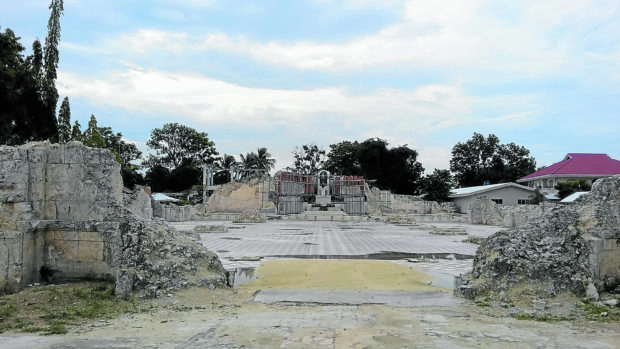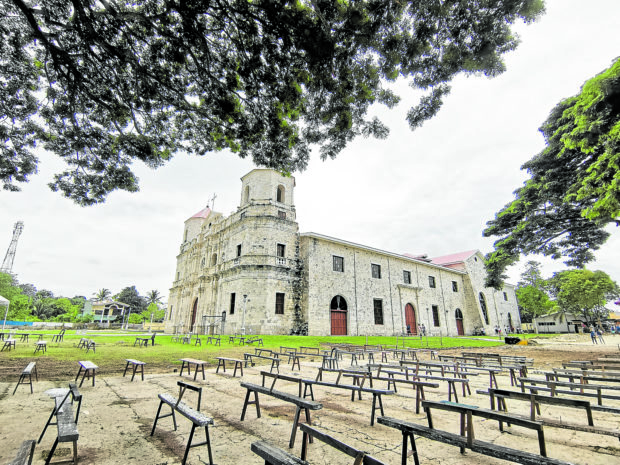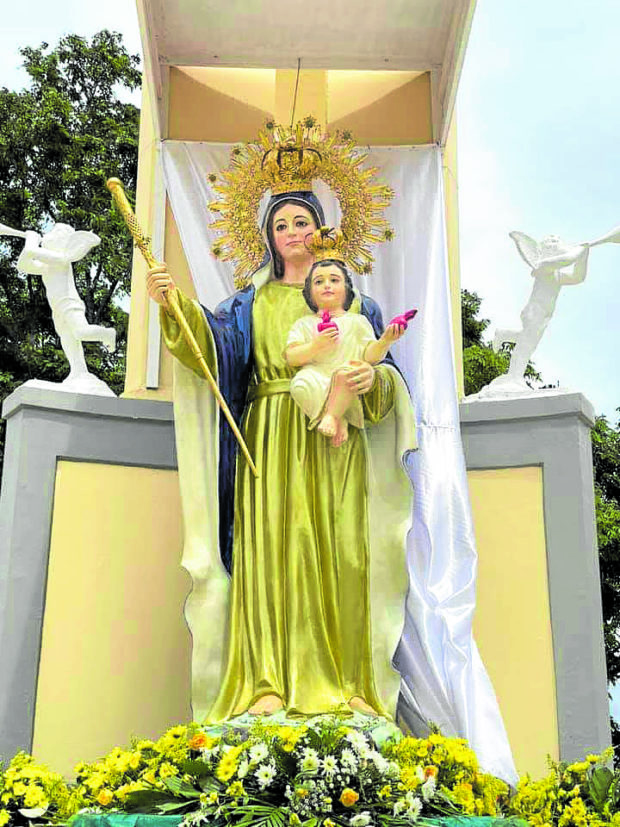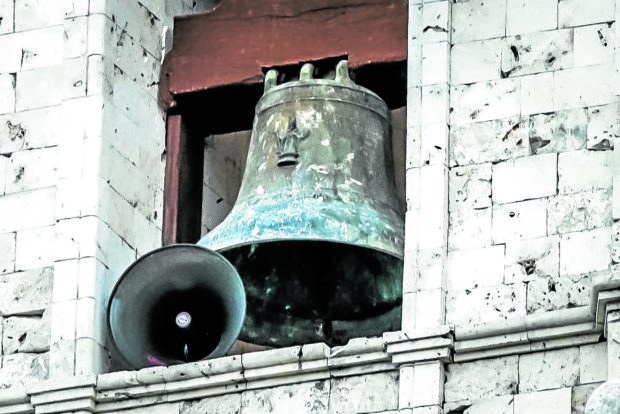Loon church rises from the rubble

QUAKE AFTERMATH In this file photo, only the floor and parts of the altar remain from the more than 150-year-old Nuestra Señora de la Luz (Our Lady of Light) church in Loon following a devastating
earthquake that struck the island province of Bohol on Oct. 15, 2013. —LEO UDTOHAN
LOON, Bohol, Philippines — For more than three decades, Mary Grace Ramada has seen a lot of changes in this town. Only one, however, remains constant: The pealing of bells at the Nuestra Señora de la Luz (Our Lady of Light Parish Church), known by many as the Loon church.
“When I hear the ringing of the church bells, it brings me joy because I always associate it as an opportunity to be with my family in order to give thanks and worship God,” said the 32-year-old professor at Bohol Island State University’s main campus who volunteers her services to the church.
But the ringing of bells on Sept. 7 was special: The familiar sound came from the newly restored Loon church, eight years after the original structure was turned into a pile of rubble by a 7.2-magnitude earthquake that shook Bohol on Oct. 15, 2013.
“It sounded great and was something that really brought our congregation together,” Ramada said.
For the people of Loon, the reopening of the church on the vesper eve of the town’s fiesta and the feast of the Nativity of the Blessed Virgin Mary was the most important event that happened in town after the 2013 earthquake.
Article continues after this advertisementThis is significant because Loonanons draw their courage, hopes, plans and aspirations from their patroness, the Our Lady of Light.
Article continues after this advertisementThe Simbahan sa Birhen sa Kasilak (Church of Our Lady of Light) straddling the villages of Moto Sur and Moto Norte is considered the largest in Bohol, with its floor area spanning 2,245.28 square meters.
It was built in 1855 by Spanish Augustinian Recollects after the old structure was consumed by fire.
Made of cut coral stones, the Loon church had only two sloping buttresses on each side of the transept. The facade exhibited baroque features and was flanked by twin bell towers.

STANDING PROUD Now that the Our Lady of Light church has been restored, Loon folk who used to hear Mass in a makeshift church set up in the parish compound may now participate in liturgical celebrations inside the new structure. —LEO UDTOHAN
Cultural treasure
In 2010, the Our Lady of Light was declared a National Cultural Treasure by the National Museum of the Philippines (NMP) due to its architectural beauty and significance on the culture and history of the Filipino people. It was also declared a National Historical Landmark by the National Historical Commission of the Philippines (NHCP) in the same year.
Three years later, the Loon church was one of the 25 churches in Bohol that were either destroyed or damaged during the powerful earthquake that also killed about 200 people in the province.
What remained standing was the church’s outdoor grotto where the statue of the Blessed Virgin stood unscathed.
Dug out from the rubble were the church’s five bells—all carved with the names dedicated to the saints—Nuestra Señora del Cetro, San Jose, San Agustin, Sta. Filomena and Sto. Niño.
Of the five, only San Jose was damaged.
The devastation of their church broke the hearts of the Loonanons.
“[With its destruction], my heart is weeping because this church is a big part of my childhood, my teenage [years] and as a young adult,” recalled Ramada.
The statue of the Our Lady of Light as well as the bells found temporary home in a makeshift church that was built near the rubble so the faithful would have a place of worship.

PATRONESS The image of the Nuestra Señora de la Luz, the patroness of Loon town, has been found intact after the 2013 earthquake in Bohol. The image is back in its rightful place at the newly reconstructed church. —PHOTO COURTESY OF TAGBILARAN BISHOP ALBERTO UY
Reconstruction
Although they knew it was a daunting task, Loonanons believed that their church would be rebuilt.
And it happened.
A team from the NMP supervised Loon church’s restoration, which cost about P142.5 million including the reconstruction of the convent.
To the delight of parishioners, the reconstructed church looks like the old one.
Local historian Marianito Jose Luspo said that months after the destructive quake, there were talks that the church would have to be rebuilt somewhere else since its original location might no longer be safe following the disaster.
“This would mean raising another structure, altogether new and modern in style, with no spiritual continuity with the faith we received from our ascendants,” Luspo said.
“Thankfully, [they] listened,” he added.
The builders also recovered and used the coral stones of the old church in rebuilding the new structure.
Except for one, all bells have also been restored at the belfries.
Bro. Farley Meredores, the church curator, said San Jose was not used because of the damage it sustained during the earthquake.
During the turnover on Sept. 7, Ramada, her fellow lay liturgical ministers and other church servants marveled at the structure’s exterior and interior details, including the murals on the ceiling and the retablo (a decorated altarpiece where images of saints are displayed) of the church, dubbed as the “Queen of All Heritage Churches in Bohol.”

PEALING AGAIN The original bells of the Loon church have been reinstalled in the belfries. —PHOTO COURTESY OF EDELIZA MACALANDAG
Faith and hope
“The structure is entirely the same as the original but the faith of the people has doubled and is fueled with much hope, especially that we are experiencing this pandemic,” Ramada said.
“I always believed that this wonderful church will get restored. I always see in my dreams that Mama Mary, the Birhen sa Kasilak, will be standing on its original place. Seeing the image of the Birhen sa Kasilak back to its original place in our newly reconstructed church made me realize that indeed nothing is impossible and miracles do exist,” she said.
The NMP turned over the church and its complex to the Diocese of Tagbilaran, which has ecclesiastical jurisdiction over the town. The turnover ceremony was attended by NMP director Jeremy Barns, NHCP chair Rene Escalante, Tagbilaran Bishop Alberto Uy and Our Lady of Light parish priest Kiking Magdoza, among others.
Barns thanked the Diocese of Tagbilaran for entrusting the church to the agency, one of the milestones in the 120-year history of the NMP.
“The Parish Church of Our Lady of Light has risen again from the rubble. Please cherish it; please look after it. May it stand for many generations to come as the treasure and pride of Loon and the entire nation,” Barns said.
Due to COVID-19 restrictions, only a few parishioners were allowed during the ceremony, the unveiling of the NHCP marker and the pontifical Mass that followed after.
Some stayed outside the church, praying and lighting candles.
In his homily, Bishop Uy pointed out that from the rubble rose a magnificent church where people could go to during religious and traditional celebrations.
“We raise up once again and build back better this temple of God. This church shall magnify Mary and her Lord. And all this is the work of God. We, who love God, love Mary his handiwork,” he said.